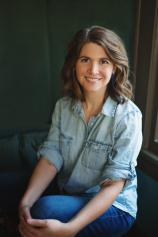This reading group guide for A PLACE AT THE TABLE includes an introduction, discussion questions, ideas for enhancing your book club, and a Q&A with author Susan Rebecca White. The suggested questions are intended to help your reading group find new and interesting angles and topics for your discussion. We hope that these ideas will enrich your conversation and increase your enjoyment of the book.
Summary
Spanning over 60 years and along the East Coast, A PLACE AT THE TABLE follows Alice Stone, an African-American chef who flees North Carolina in the 1930s; Bobby Banks, a Southern Baptist preacher’s gay son who moves to New York City just before the AIDS epidemic begins; and Amelia Brighton, a newly-single Connecticut mother of two who yearns to rediscover herself after a painful separation. While their backgrounds vary, each character becomes inextricably linked to Café Andres, a hole-in-the-wall Manhattan restaurant made famous by Alice’s cooking and its clientele. As Alice, Bobby, and Amelia persevere through personal struggles, broken hearts, and secrets, they ultimately discover the power food --- and love --- possesses to bring people together both within and beyond the kitchen.
Discussion Questions
1. In Alice’s prologue, language is a symbol of empowerment and oppression for her family, and her relatives both pride themselves in their ability to speak well and manipulate their speech to avoid social conflict. Are there other instances in A PLACE AT THE TABLE where language and speech are politicized in a similar way?
2. Alice, Bobby, and Amelia all escape to New York City from their hometowns in order to start over. Why do you think the author chose New York City as the uniting city? Would any other city work as well as a melting pot for the characters?
3. Who is your favorite character in the novel? Explain your answer.
4. Café Andres is loosely based on Café Nicholson, a historic Manhattan restaurant known for its clientele. Can you think of any other restaurants that you have either visited or heard of that are similar to Café Andres?
5. Cooking is practically a religious experience for Bobby. After he moves to New York City, it takes perfecting his cooking at Café Andres for him to start hearing God “knocking on [his] heart once again” and feeling a sense of home (p. 158). Why do you think cooking heals spiritual wounds that even the act of moving away from home cannot cure? Does Amelia have a similar experience with cooking?
6. In order to assimilate Bobby’s recipes into the Café Andres menu, he invents what he calls “stealth southern cuisine,” which is a combination of his Southern cooking background and the café’s French-inspired cuisine. What are some other hybrid food genres? What is your favorite food genre?
7. After Bobby’s “failed” first dinner with Alice and subsequent promotion, he describes the experience as one where “the universe delivered me a beautiful gift wrapped in hideous packaging” (p. 169). Does Bobby receive similar gifts at any other point in the novel? Could Bobby’s friendship with Alice after Sebastian’s death be considered such a gift?
8. Bobby struggles with religion throughout the story and is notably rejected from the Catholic communion. If you were Bobby, how would you have reacted to such a rejection? Do you think it’s possible for Bobby to resolve his issues with faith and religion?
9. In her discussion with Bobby about grief food, Alice says, “Cooking is the one thing that has never failed me” (p. 219). Is this true for other characters in the novel? Are there any infallible people?
10. There are many boundaries in A PLACE AT THE TABLE, from racial segregations to religious and sexual orientation differences. What cultural tension is the most harmful in the novel? Do these tensions still exist in today’s society?
11. Northern and Southern customs and manners are frequently at odds in A PLACE AT THE TABLE; these differences are partly responsible for Bobby’s awkwardness with Sebastian’s parents and Amelia’s struggles with her in-laws. Are these issues inevitable? Have you experienced similar demographic tensions?
12. A PLACE AT THE TABLE is filled with secrets and devastating revelations. What was the most shocking surprise? Did you foresee the final plot twist?
13. Discuss what you think is the book’s main takeaway message. If you could ask the author one question about the book, what would it be?
Enhance Your Book Club
1. The art of cooking connects many of the characters in A PLACE AT THE TABLE. Bring your favorite recipe or cookbook to share with your reading group.
2. Feeling adventurous? Turn your book club meeting into its very own Café Andres! Have members prepare favorite dishes, bring tablecloths and silverware, and maybe dress up as their favorite historical Café Andres patron. Get creative!
3. Learn about the fact behind the fiction. Research the legendary Southern chef Edna Lewis and historic Café Nicholson that inspired the creation of Alice Stone and share your findings with your book club.
4. Learn more about author Susan Rebecca White. Visit her website: www.susanrebeccawhite.com and stop by her Twitter and Facebook pages.
5. Have a Susan Rebecca White reading challenge! Read her other two novels, BOUND SOUTH and A SOFT PLACE TO LAND and hold a separate conversation about all three books.









